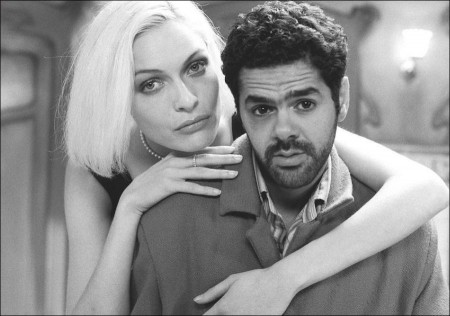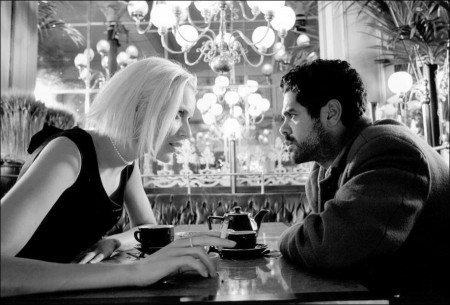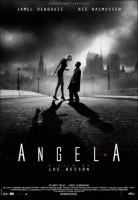A is for Actors
I didn’t miss the actual process of directing all that much. It’s a full-on mission and a responsibility that demands so much time, energy and perspiration that you don’t necessarily want to go back to it right away. To me, directing is a bit like a sailor in a single-handed round-the-world race: you have unforgettable memories but you don’t actually want to set off again as soon as you reach dry land.
On the other hand, when I arrived on set, it was a huge pleasure to be with actors once more. The rehearsal period of six weeks with Jamel and Rie was particularly exciting. Seeing the text take shape through them, witnessing the enjoyment bubbling up, the first smiles, is pretty amazing. It reminds me of the development of a baby, who begins to take in the world around, and then interact with it. The pleasure is very similar. You are seeing something being born.
B is for Besson
I began writing this film ten years ago. I had developed the bare bones of the story but I was incapable of putting the words into my characters’ mouths, probably because I was too young. I wanted to tackle this subject but I didn’t have the necessary vocabulary. So I put my fifteen pages to one side and came across them again much later almost by accident. When I read them through, I found it very contemporary and decided to get back to work to see if I could write it this time. The script was ready two weeks later! I suppose you might say that I spent ten years and two weeks writing the film…
C is for Cascades (of action and words)
There aren’t any stunts in the film, or only one that’s so tiny that after all the stunt-action movies I’ve produced, it doesn’t actually feel like it’s a stunt! On the other hand, there’s a real cascade of dialogue. It’s a very talkative movie, with the two leads chattering away like a couple of hens.
D is for Design
For the first time ever, because I often work with same two production designers, who have got to know me too well, I “recounted” the film’s settings to the production designer without giving him a script to read, so he had no idea what the film was about.
I was convinced that he would come up with ideas that he wouldn’t have had if he knew the story of the film, and that’s exactly what happened. If he’d read the script, neither of us could have dreamed up the sets he eventually created, and which help the film to move forward at times. I adopted the same technique with the rest of the crew, for whom the shoot was like a soap opera – since we were shooting in chronological order, they discovered what the film was about as they were making it. They only got to know how it all ends on the last day of the shoot!
E is for Elegy
(After much thought) I don’t get the sense that the film is in homage to anything, at least not deliberately. As far as Paris is concerned, it’s a declaration of love more than an elegy. I find that recently French movies have missed out on the beauty of Paris when for me it truly is the most beautiful city in the world.
F is for Faithful
I am undeniably faithful to my crew but when you’re working, fidelity shouldn’t be confused with blindness. I’m often friends with my technicians but I never choose them out of friendship. I keep working with the same ones because they are smart enough to evolve between each film I make. Considering the creative responsibility they have on each project, it’s important for me that they don’t just stand still. I need them to want to keep improving. I don’t set out to “use” them but to share their knowledge.
G is for Gilbert Melki
Gilbert is an actor I had kept an eye on for some time and the role fits him like a glove. He was the first person I thought of to play Franck and I was very pleased when he said yes. I didn’t give him the script to read either because his character sees André, played by Jamel Debbouze, evolve and I thought it would be interesting to see Gilbert wondering about the origins in the changes he saw in André in each scene they had together. I think that not reading the script helped him to understand his character: he was hungry for it. The end justifies the means!
H is for Her
Since Rie was a total unknown, I didn’t see the point in releasing her name, which meant nothing to anybody. But people are made in such a way that they are more interested by what you don’t tell them than by what they know. When I saw some of the rumors on internet, without it being a strategic decision, I got a real kick out of keeping up the suspense…
I is for Images
Ten years ago when I first imagined the film, the images were in black and white. They were mostly images of Parisian bridges and more particularly of certain places in Paris from where you can see a series of bridges spanning the Seine one after the other.
J is for Jamel
The first time I saw Jamel was on the French cable channel Canal + giving a hilarious review of Titanic. He reminded me of Zebedee, an endearing character that you sense is full of life, wit, charm and, at the same time, scarred by life, which makes the actor even more interesting. We bumped into each other a few times after that and got on well without ever being very close. Then, I realized that he was ready to take the plunge, to take on a leading role and take the character to the edge. As a director, it’s an exciting challenge. You feel a bit like an explorer.
K is for Kubrick
I take no pleasure in going over old ground, probably because of my admiration for Stanley Kubrick and Milos Forman, who were constantly moving onto new things. Like them, I try to force myself not to make a “Luc Besson” movie, not to direct another Nikita (1990) or another Leon, despite being asked to do so all the time. Moreover, the thing that I particularly admired about Kubrick was the osmosis between his visual style and the story he was telling. His visual language was a perfect fit for the mathematics of his subject every time. Likewise, Orson Welles came up with ideas, shots and games with shadows that were just right for the subject every time. That encouraged me always to make sure that the way I shoot is in tune with the story I am telling.
L is for Light
The light was essential, since we shot the film in July and August – when Paris kind of empties out – according to quite an unusual schedule, shooting from 5 – 10 in the morning and then in the evening. We shot tests of every aspect of the movie in black and white, with a special treatment of the film – to the extent that it looks absolutely terrible in color. No way would anybody ever want to color this film!
M is for Montage
After so many rehearsals, it was a real pleasure in editing to have the choice between two, three, four or even five good takes. That meant I didn’t have to edit shot/counter-shot to get each character speaking at just the right time. There are a lot of scenes in the film where Jamel and Rie are both in the frame, real “actors’ moments”. That’s only possible if you rehearse a lot before the shoot and if the actors are totally focused on the set, which was the case here.
With experience, you also realize when you’re editing that there is less film left on the floor: you pre-edit the film almost as you shoot it. Generally, I knew on set what I would keep and what I would lose, the cutaway I didn’t have and so on. On my early films, when I got to the editing room, I’d always be grumbling that I didn’t have certain shots and I’d go back to shoot them. Not only is that a thing of the past, but also the whole editing process is much quicker.
N is for Black `N’ White
The critics will probably say that I have consciously made my first and last film in black & white, but that’s absolutely not so. There are four characters in the film: Angela, André, Paris and the black & white. They are like the different aspects of a poem and if you take one of them away, you take some of the poetry out of the film.
O is for Original (Score)
I discovered Anja Garbarek through a small photo in the newspaper. I knew Jan Garbarek, the saxophonist who played with Keith Jarret in the 70s and 80s and I was curious to listen to his daughter’s music after I sensed that she had grown up surrounded by Stanley Clarke and Miles Davis. I went out and bought her first two albums. They were magnificent. They revealed a genuine jazz heritage and a voice that resembles Björk’s with even more softness and poetry. That was at precisely the same time that I had pulled out of nowhere those few pages of a script. So I wrote the film while listening to those two albums.
From the very beginning, the music was linked to the story and they continued to inform each other. At the time, the composer I usually work with, Eric Serra, was already working on Arthur and the Minimoys. It would have been difficult for him to compose for two films at the same time, so I was unfaithful to him for a film. Having said that, Jean Réno and Eric Serra make films without me, so I don’t see why I shouldn’t make a film without them at least once in my life. So, Anja Garbarek composed the original music for Angel-A, which also features a few themes from her earlier albums, which we rearranged.
P is for Paris
I have always adored Paris but working on a film for the city’s Olympic Games candidacy forced me to take a new look at the city and that was a great inspiration. It was like meeting up with a former mistress! Working on my early movies, I spent a lot of time under her skirts, in the gut of Paris (The Last Combat – 1983, Subway). Now that I had grown up and I was her size, we could waltz together…
Q is for Quality, #1
For a film of this kind, the quality you most need is discipline and veracity. You can’t lie to yourself. You owe it to yourself to be honest about what you say and the way you say it.
R is for Rie Rasmussen
We could also say that “R is for Rare”; In Rie, I found a rare pearl. I have never met a woman like her, in love with everything, curious about everything, and so gifted – she paints, draws, takes photos and directs. Wherever she goes, she spreads happiness and smiles. Her enthusiasm was a real boost for me and made me want to shoot a film again.
S is for Success
It’s amazing how the success of a film undermines its status as a “personal” piece of work. After more than ten million people went to see The Big Blue, it was no longer considered a personal film but a mainstream picture. In fact, it’s hard to imagine a more personal movie – I wrote it when I was sixteen, when very few people knew about the sport of diving without oxygen or the relationship humans could develop with dolphins, not to mention that it’s the story of a guy who doesn’t feel right on land and would have preferred to be born in the water!
T is for Thierry Arbogast
A usual suspect! One of the things I like about Thierry is the work he does with other directors! He has worked a lot in the States, and with Russian, British or Chinese filmmakers. As a result, it’s always a huge pleasure for both of us to hook up again, because we have new discoveries to share each time. Also, we know each other so well that no time is wasted. We understand each other instinctively, without really having to talk a lot. It’s a great partnership, especially as there are no ego problems between us – on a shoot I have to fiddle with everything, even the position of a light. I work on the principle that I can have something to say about everything because it’s my film. Thierry accepts that easily, unlike certain DPs, especially in commercials. Thierry likes sharing.
U is for Ubiquity
For any given task, if I feel that somebody is better at it than me, I don’t think twice, I give them the job to do. On the other hand, if I have the sense that I can do better, I do it. It’s pretty healthy, in fact, and has nothing to do with any control-freakery. It’s all about being efficient. Sometimes, I’ve already started something by the time I realize that somebody is more “capable” than me, so I leave them to get on with it. As long as we reach our goal – for the film to be as good as it possibly can be – who cares who’s wearing which hat! Especially as you usually take one hat off to put another one on: the writer writes, the director prepares and then rehearses with the actors, the producer makes his contribution. On this film, the producer didn’t have much to do – the director hardly ever listened to him!
V is for Viewing
You reach a point where you disconnect from the sheer pleasure of watching because you’re preoccupied with technical issues like transitions and sound. You forget that you have a Ferrari that’s going out to race because you have your nose in the engine and you’re so busy doing the fine-tuning that you forget to think about happiness and emotion. Once the hood is down, you’re able to let go and watch it drive with pleasure.
W is for Weekend
I don’t know what the word means!
X is for X-rated
Strictly speaking, there are no love scenes in the film. There are many subjects that I enjoy dealing with, but sex or screen nudity has never interested me. To my mind, it’s something intimate, which should be experienced directly, not watched, and that’s as true for the director as for the audience. On the other hand, everything that comes before “bed” is wonderful: a declaration of love can be played out in infinite variations. You can’t get bored of Romeo meeting Juliet, but to be honest, their love scene is of absolutely no interest. Unless, you film it like Beineix in Betty Blue, when the girl says “it was the first time we saw each other in the daylight” after the love scene that opens the films. It has meaning, it adds something to the story.
Y is for “You have anything else to say?”
No, everything else is in the film.
Z is for Zen?
I was very scared after my first film that nobody would let me make another one. I was very scared after my second film that nobody would let me make a third. After twenty-five years in the business, I say to myself now that if I never make another movie, it’s not the end of the world! I must be more “zen” and less and less anxious about success or money. Having lived through eight film releases, I know now that only the quality of the film is left. Am I happy with the result? Do I think I did my best? What is left of the film five years later? That’s what counts. The rest is all forgotten – the little hassles around the release. Ten years down the line, not much remains of that.
Related Links
Angel-A
Starring: Jamel Debbouze, Rie Rasmussen, Olivier Claverie, Gilbert Melki, Kate Nauta, Serge Riaboukine
Directed by: Luc Besson
Screenplay by: Luc Besson
Release Date: May 25th, 2007
MPAA Rating: R for language and some sexual content.
Studio: Sony Pictures Classics
Box Office Totals
Domestic: $202,647 (2.0%)
Foreign: $9,792,521 (98.0%)
Total: $9,995,168 (Worldwide)


